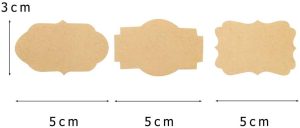Streamlining inventory management with barcode labels offers numerous benefits to businesses, improving accuracy, efficiency, and overall operations. Here’s how barcode labels can be used to streamline inventory management:
- Accurate Data Entry: Barcode labels eliminate manual data entry errors. Scanning barcodes during stock intake, sales, and restocking ensures that accurate product information is recorded, reducing discrepancies between actual and recorded inventory.
- Real-Time Updates: Barcode scanning provides real-time updates on inventory levels. This allows businesses to make informed decisions about restocking, purchasing, and sales based on up-to-date information.
- Faster Stocktaking: Traditional manual stocktaking can be time-consuming and error-prone. Barcode labels enable rapid and accurate stocktaking by simply scanning items, minimizing the disruption to daily operations.
- Efficient Replenishment: Low-stock items can be quickly identified by scanning barcode labels. This enables efficient restocking, ensuring shelves remain well-stocked and minimizing lost sales due to out-of-stock items.
- Data-Driven Insights: Barcode data can be used to generate insights into sales trends, product performance, and customer preferences. This information guides inventory management strategies, marketing campaigns, and decision-making.
- Automated Alerts: Barcode systems can generate alerts when inventory levels reach predefined thresholds. This ensures that reorder decisions are made promptly, preventing stockouts and disruptions in supply.
- Order Accuracy: Barcode scanning improves order accuracy when fulfilling customer orders. Scanning products before shipping ensures that the correct items are included in each order.
- Reduced Labor Costs: Automating inventory management through barcode labels reduces the need for manual counting and data entry. This leads to reduced labor costs and allows employees to focus on higher-value tasks.
- Improved Customer Satisfaction: Accurate inventory management means fewer instances of customers encountering out-of-stock products. This leads to higher customer satisfaction and loyalty.
- Enhanced Demand Forecasting: Historical barcode data can be used to analyze demand patterns over time, helping businesses forecast future demand and optimize inventory levels accordingly.
- Vendor Relationship Management: Accurate inventory data enables businesses to negotiate better terms with suppliers and improve relationships by ensuring consistent orders and timely payments.
- Supply Chain Transparency: Barcode labels enable traceability throughout the supply chain, allowing businesses to track the movement of goods from suppliers to customers.
- Integration with Software Systems: Barcode systems can be integrated with inventory management software, enterprise resource planning (ERP) systems, and point-of-sale (POS) systems, creating a seamless flow of data across different departments.
- Warehouse Organization: Barcode labels can be used to assign specific locations to products within a warehouse. This improves picking and packing efficiency by guiding employees to the correct storage locations.
Incorporating barcode labels into inventory management processes can lead to significant improvements in accuracy, efficiency, and decision-making, ultimately contributing to better overall business performance.

